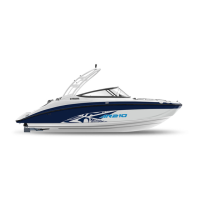Overtaking
If you are passing another vessel, you
are the give-way vessel. This means
that the other vessel is expected to
maintain its course and speed. You
must stay out of its way until you are
clear of it. Likewise, if another vessel is
passing you, you should maintain your
speed and direction so that the other
vessel can steer itself around you.
OTHER SPECIAL SITUATIONS
There are three other rules you should
be aware of when operating your boat
around other vessels.
Narrow Channels and Bends
When navigating in narrow channels,
you should keep to the right when it is
safe and practical to do so. If the oper-
ator of a power-driven vessel is prepar-
ing to go around a bend that may
obstruct the view of other water ves-
sels, the operator should sound a pro-
longed blast of four to six seconds on
the horn. If another vessel is around
the bend, it too should sound the horn.
Even if no reply is heard, however, the
vessel should still proceed around the
bend with caution.
Fishing Vessel Right-of-Way
All vessels fishing with nets, lines or
trawls are considered to be “fishing
vessels” under the International Rules.
Vessels with trolling lines are not con-
sidered fishing vessels. Fishing vessels
have the right-of-way regardless of
position. Fishing vessels cannot, how-
ever, impede the passage of other ves-
sels in narrow channels.
Sailing Vessel Right-of-Way
Sailing vessels should normally be
given the right-of-way. The exceptions
to this are:
1. When the sailing vessel is overtak-
ing the power-driven vessel, the
power-driven vessel has the right-
of-way.
2. Sailing vessels should keep clear of
any fishing vessel.
3. In a narrow channel, a sailing vessel
should not hamper the safe pas-
sage of a power-driven vessel that
can navigate only in such a channel.
SAFETY INFORMATION 1
1-19
1 SAFETY INFORMATION
1-18
“1” “3” “5” “7”
LIGHTED BUOY (Port Hand)
Odd number, increasing toward head
of navigation. Leave to port (left) pro-
ceeding
White Light Green Light
OR
Old New
“2” “4” “6”
LIGHTED BUOY (Starboard Hand)
Even number, increasing toward head
of navigation. Leave to starboard
(right) proceeding up-stream
White Light Green Light
OR
Old New
“A”
LIGHTED SAFE WATER BUOY
No number. Marks midchannel, pass
on either side. Letter has no lateral sig-
nificance, used for identification and
location purposes.
Top Mark
White Light Green Light
OR
Old New
RB “L” RB “L”
LIGHTED PREFERRED
CHANNEL TO PORT BUOY
No number. Topmost band red -
preferred channel is to left of buoy.
Letter has no lateral significance,
used for identification and location
purposes.
Red or Red
White Light Light
OR
Old New
N “2”
NUN BUOY
Even number. Leave to starboard.
No change
C “1”
CAN BUOY
Odd number. Leave to port.
OR
Old New
SECONDARY CHANNEL BUOYS
STARTS NEW NUMBERING SYSTEM
Proceeding toward head of
navigation from seaward
MAIN CHANNEL
SECONDARY CHANNEL
“7”
“6”
C “1”
N “2”
RB “L”
or
RG “L”
“5”
“4”
“3”
“A”
“2”
“1”

